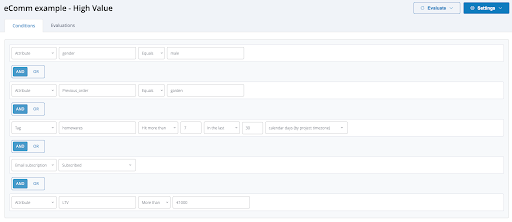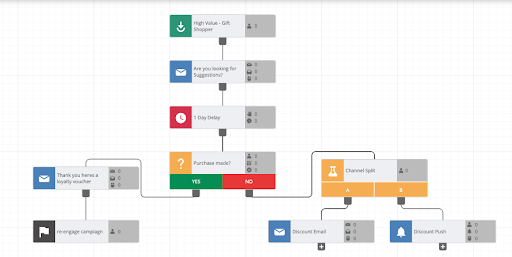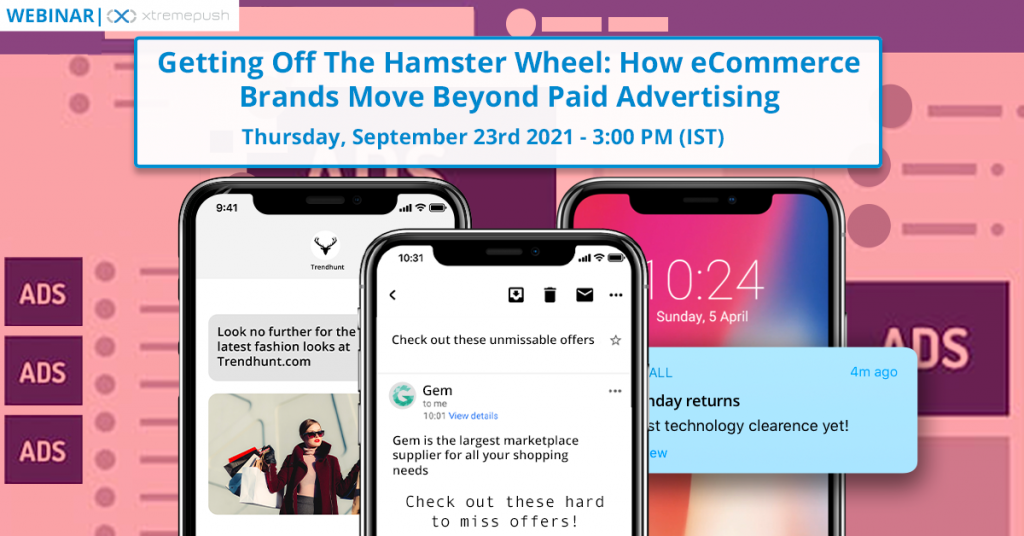On August 23rd, Xtremepush and our friends over at Grow Consultancy held an in-depth, practical webinar on the paid advertising industry and how brands should act in the space.
You can access the webinar here to watch it. But for those of you who don’t quite have the time, here’s a quick recap of the main talking points and use cases that we saw throughout it.
Watch on Demand
Getting Off The Hamster Wheel: How eCommerce Brands Move Beyond Paid Advertising
We opened up the webinar with an introduction to both Xtremepush and Grow Consultancy, then moved on to a brief chat about their experiences with both paid advertising and using owned channels. This chat encapsulated the overarching theme of this webinar, which is that businesses should try to focus on their own channels as much as they can.
Of course, paid advertisement does have its place in your strategy and can play an important role, but depending on it too much means that you’ll likely be stuck with relying on it forever.
Trends in the industry
We touched on a few trends in the industry that businesses should have on their radar. The removal of 3rd party cookies on Google Chrome and iOS has been something that’s been on the minds of marketers in recent times. We discussed briefly how this change can be dealt with by companies. The answer being implementing first party data.
Another trend that was looked at is the current domination of video content in the industry. Social media platforms like TikTok, Instagram, and YouTube are starting to take over the ads space and companies can reap serious rewards if used correctly.
So, how do eCommerce companies respond to these trends?
The short answer here is what is referred to as growth marketing. At the bare bones of it, businesses should conduct a lot of experiments, get really familiar with the data, then share the results with your team.
We briefly touch on some questions to ask yourself when looking into growth marketing, such as: Who are my customers? Where do they spend their time? How can I target them without ad spend? How can I get them to purchase more often?
We then touched on how important it is to know your metrics. We’re given a quick formula to follow which could really help your business to grow:
Website traffic per month x Conversion rate to purchase x Average order value.
Next up was how companies can go about acquiring your customers. There are of course many other channels by which you can acquire them, but here are a few that were suggested in our webinar.
SEO – This can obviously deliver a lot of “free” traffic without media spend. But it requires a lot of technical skill and can take time to perfect and deliver the results you want.
Email Marketing – This is the ultimate permission based marketing tool. The automation and targeted aspect of it is incredibly valuable. However it can take time to build up a good list.
Blogging & Content Marketing – Can give you lots of free traffic, especially when combined with good SEO. Delivering it at a good standard and on a regular basis does take time and commitment.
Influencer Marketing – This can be a cost effective way to deliver traffic and also establish trust in your brand. It can however be difficult to track your results.
This section of the webinar ends with a quick case study on how an Irish retailer used growth marketing to increase their revenue through a few small changes. The steps that were taken were fairly straight forward but very valuable. First was a quick review of the eCommerce function. Then they implemented email marketing automation. Content planning, SEO, and video production training was given to all staff. Then finally, dashboards and reporting tool were set up for the senior management team.
Simple steps were taken which brought them great rewards.
The Why and How of First Party Data
The introduction of first party data was mentioned earlier as a way of combating the changing trends in the industry. We discussed why it’s useful and how to go about collecting it.
- It gives you better audience insights. This includes things like demographics, interests, preferences, and behaviour.
- The predictive analytics aspect of it can help you serve up segments that are much more likely to convert.
- It gives you the resources to personalise and align content and campaigns with user’s interests and preferences, which increases engagement and conversions.
- Finally, for prospects that do not convert, you can retarget them on your site or through outbound marketing.
We then took a look into how brands can go about collecting their first party data. This can be done a number of ways, but here’s how we suggest doing it.
- Using your eCommerce solution or Google Tag Manager to track transactions and behavioural events.
- Soliciting first party data via surveys and preference centers.
- Using identity resolution to identify users across multiple platforms and devices.
- Audience segmentation to define cohorts of users in-house for activation.

What brands are doing well with Xtremepush
The final section of the webinar included a look at what current brands using the Xtremepush platform are doing well.
Currently, we can see that a lot of brands are indeed following the steps that we have suggested taking throughout this webinar. They are building up their own walled garden of first party data, and investing in their own channels.
For Xtremepush, our email channel is still the best performing one for eCommerce brands. But a lot of brands in this space are developing a multi channel mix to their campaigns. They are also layering behavioural data with profiles and CRM data for a much richer segmentation.
We have noticed that brands are currently exploring mobile apps and what they can do with them. But with their websites, we have noticed good use of tags and events to inform their customer journey and automation.
The webinar closed with a quick look at the Xtremepush platform and show off how easy it is to create customer segments and visualise the customer journey with our Maxautomation tool.

Takeaways
If there’s anything you can take away from this webinar, it should ideally be these five.
- Paid Advertising is a hamster wheel – you stop spending and it stops spinning!
- Upcoming changes to 3rd party cookies will impact view-through-conversions & lookalike audiences
- Ad spend and competition on social media platforms will increase
- eCommerce brands would do well to invest resources in their owned channels to drive repeat sales
- The gathering, unification and activation of first party data is essential
About Xtremepush
Xtremepush is the world’s leading customer engagement, personalisation and data platform. We work with leading brands in the eCommerce industry. Schedule a personalised demo of our platform to learn more about how we can help your brand drive revenue.
